THE FEARLESS VAMPIRE KILLERS:
A Tale of Two Versions
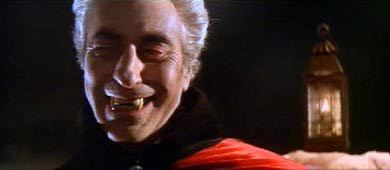
*Revised footnote below, 12/8/99
The story of how a wonderful film was mutilated, forgotten, rediscovered and restored - Ten Years before Home Video!
Roman Polanski's delightful The Fearless Vampire Killers, or, Pardon Me, but Your Teeth are
In My Neck has a fascinating and little known release history. Before Home Video,
this film was known in the United States only in a severely re-edited version, one which
Polanski disowned completely.
Scripted and filmed as Dance of the Vampires, an elegant title retained everywhere
except the United States, Killers was emigré Polish director Roman Polanski's first
bigscale production. Straight from Polanski's international success Repulsion, it was
mounted on a lavish scale - color, huge sets in England, location filming in the Alps,
elaborate costumes and choreography suitable for a period epic. Previously accustomed
only to extremely low budgets, Polanski chose some of the finest English cinema craft
artists to work on the film: cameraman Douglas Slocombe, production designer Wilfrid
Shingleton. Polanski engaged noted choreographer Tutte Lemkow, who played the
actual Fiddler in Fiddler on the Roof, for the film's climactic Danse Macabre minuet.
The film got even bigger when the director decided to switch formats to Panavision
while filming on location. Flat scenes already filmed were optically converted to
match. For Savant-types this accounts for the slight compositional crowding North-South
on some of the Alpine exteriors. There is also at least one shot of demented hunchback
Koukol's coffin-sled crashing into the trees that was used without re-formatting,
resulting in a more 'readable' but horizontally stretched image.
Except for a few reports of the director clashing with his English crew over Union rules,
there are no accounts of anything but a smooth filming for Dance. Polanski had
considerable acting experience and added to his challenges by playing a main role. Yet
the direction of the film appears to be as precise and effortless-looking as the best of his work.
Dance of the Vampires was immediately embraced by European audiences who were enchanted
by the film's unique blend of fairytale beauty, sly comedy and baleful horror. It was
only on import to the United States that the trouble began. For its American release,
Dance of the Vampires got not only a new title (or three) but was subjected to a
merciless editorial revision.
1
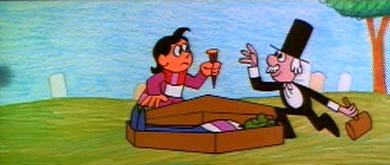
It's easy to see what the revisionists had in mind. This was no cheap chop-job; the
changes started right at the top with an expensive animated cartoon prologue showing
caricatures of the vampire hunters trying to dispatch a chortling, Dracula-style vampire.
The purpose of the prologue seems to be to re-acquaint audiences with the standard
anti-vampire methods, even though the popular Hammer films and TV reruns of the Universal
originals should have given the revisionists a clue that a primer wasn't necessary.
Audiences I saw the film with in 1970 thought this cartoon amusing, but its tone created
false expectations for broad slapstick that the feature doesn't fulfill.
The animated cartoon concluded with MGM's Leo sprouting cartoon fangs, which indeed
got a big laugh. In Polanski's original the Leo logo fades up normally, then suddenly
morphs into a baleful green ghoul who just stares out from the screen.
It's a chuckle moment, but with a hint of discomfort - this silly 'toon is creepy, too.
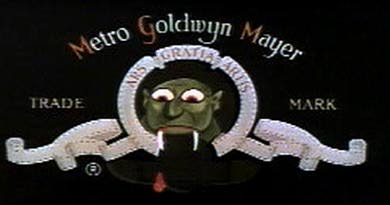
Luckily, no one thought to remove Krystof Komeda's wondrous music with its weird choral
effects and little melodies that show up at what in a normal film would be inappropriate
moments, like vampire attacks. Never resorting to cliché, Komeda's score
communicates the Kafka-like isolation of the setting and the characters. The quivering
choral harmonies lend an extra chill to the cold surface of the moon and magic to
those little frozen vistas glimpsed through tiny castle windows.
The entire role of Professor Abronsius (Jack MacGowran of The Quiet Man and
The Exorcist)
was revoiced and redubbed. This demoted Abronsius from bizarre leading player
to comedy relief, and essentially scuttled the story's fragile balance of characters.
The redubbed Professor may have been more accessible - he tends to grunt and quack his
way through his lines in the original - but it also made his assistant Alfred's devotion
seem ludicrous instead of touching. The key moment for this is when Alfred carries
his master across the castle battlements. Abronsius, as blind as ever to his disciple's
heroic efforts, rhapsodizes on the beauty of nature. With a redubbed Saturday-morning
cartoon voice the line became just a not-so-funny throwaway. In the original, the
Professor's frustrating lack of sensitivity to the problems
of people around him makes an entirely different statement. Polanski's films often
deal in contrasts of master and servant, the empowered and the powerless. The supposedly
benign Abronsius callously bullies Alfred for his own purposes, just as the vampires
consider all of humankind a resource to be harvested. Nowhere in vampire films before
was the aristocratic nature of Dracula used to make such an effective statement about
the 'natural order of things'.
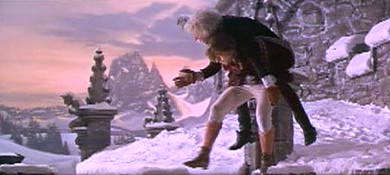
With the animated prologue added, it means that the original European film was actually
shortened by as much as twelve minutes. What was missing in the original American
release? Parts of sequences and entire scenes that establish creepy moods and
illuminate characters. Jettisoned: Innkeeper Shagal stomping sauerkraut and staring
at barmaid Fiona's rump as she scrubs the floor. Parts of the snow journey to the
Count's castle. Also dropped was a key scene of Alfred searching through dank
corridors for the source of an eerie voice which might be that of his beloved Sarah.
He blocks a doorway with a chest of drawers (a recurring Polanski motif) and climbs
back into bed; in both versions the hunchback Koukol stumbles into the shifted chest,
a gag that makes no sense in the short version. A small but effective snip was the
telescope view of the lifeless but beautiful planet Saturn, a bit that neatly evokes
Abronsius' appreciation of cold scientific infinity. Having so little comprehension
of humanistic values, it seems perfectly logical that the Professor would be tempted
by the prospect of spending a deathless eternity researching the Count's library.
The altered cut tries unsuccessfully to maintain a slapstick comedy tone and blunts
Polanski's clear message: the ineffectualness of virtue in the face of organized Evil.
It is a theme shared by Rosemary's Baby and Chinatown and present to some degree in
Polanski's entire filmography.
Much of the narrative is a series of frustrations as the heroes drift away from their
mission through various distractions and mishaps. Alfred in particular seems
incapable of staying on-task - doomed by his own virtue, innocence and human caring.
Polanski and scenarist Gerard Brach's underlying message is that virtue and decency
are delicate qualities unsuited for defeating Evil. Unlike the united and motivated
vampires, the 'good' humans exist in Kafka-esque isolation one to another, weakened
by self-doubt, ignorance and petty vanity. Unified action is impossible when even
the simplest communication between the human heroes results either in misunderstanding
or total incomprehension. Only too late do Alfred and Abronsius begin to become
effective, deftly using their wits to improvise a crucifix from crossed swords, or
smashing a door with a steam-powered cannon. The best is a scene (originally cut,
of course) showing Abronsius shouting down a chimney flue at Shagal. The tyro vampire
actually takes heed because he thinks Abronsius to be the voice of God: "Don't you touch her!"
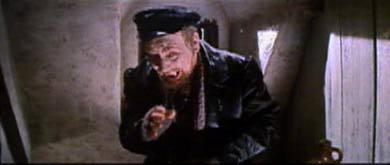
Savant has heard it remarked that some of the characterizations, Innkeeper Shagal
especially, are anti-Semitic stereotypes. I think this to be a pretty shallow reaction;
I just don't associate Polanski's motives, here and
in the rest of his films, with anything so crude as anti-Semitism. Shagal's petty
and avaricious behavior would seem more to be Polanski's refusal to sentimentalize
ignorance and poverty rather than some ethnic statement. When still human, Shagal
defends his daughter and home with his very life. He's no more offensive or less
human than Tevye in Fiddler on the Roof. The Fearless Vampire Killers is just a
less sentimental story.
Polanski's aim surely was the construction of a fairytale - the original kind with horror
and humanity - but devoid of easy sentiment. It's Into the Woods minus hope
and happy
endings, plus lots of snow. Polanski's Count Von Krolock owes little to either
Universal's Lugosi or Hammer's Chris Lee (Ferdy Mayne, who plays the Count, passed away
early in 1998) and the film is several notches above the average Hammer in both
conception and achievement. Polanski has drawn from the entire spectrum of the Horror
genre, as indicated in arcane details like the fact that Alfred's and the Professor's
costumes are copied from characters in Murnau's Nosferatu and Dreyer's Vampyr. Poetic
and bizarre original touches abound, such as the Franju-like moment in Sarah's bath
comparing the textures of first soap bubbles, then falling snowflakes, and finally crimson blood.
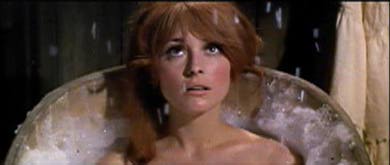
Many critics call The Fearless Vampire Killers Polanski's odd film out, an aberration
in his catalog of titles. Nonsense. The cruel 'the vampires win' climax adheres
strictly to the axiom: no matter how bad you think things might turn out, in a Polanski
film, they'll end up worse.
The other Polanski that most resembles this Vampire ballet? Tess, a period film of
souls trapped in an enclosed and stifling world ruled by cruelty and class oppression.
There is a slow pan around a farm room filled with hanging cheeses (I think) in Tess
that looks exactly like a creepy interior from Killers.
Indecision must have reigned at the film's 1967 American release because advertising materials
exist under 3 titles: The Fearless Vampire Killers, or, Pardon Me, but Your Teeth are
In My Neck, The Vampire Killers, and, simply, Your Teeth in My Neck. After all
the effort (and some beautiful Frank Frazetta poster artwork in the What's New, Pussycat? /
After the Fox merry chase style) the film got a very minor release. Most people saw it in an
unfortunate double bill two years later with Valley of the Dolls, an ugly attempt to
exploit Sharon Tate's notoriety following the Manson killings. Unfortunately, for many who saw
it then, the film still carries a sick pall of association with that dark September's attempt
by the media to portray Roman Polanski as somehow satanically involved in those awful murders.
Combine the confusion of those tragic events with the mutilated American release and you
get some understanding of how the original film became an unsung treasure, Hiding In
Plain Sight. Around 1979, MGM began distributing the original cut to repertory &
revival houses where it has remained an obscure but steady visitor. I myself caught
it in Ensenada in 1982 in a Spanish-subtitled print that had a full theater of Mexicans
alternately laughing and gasping in surprise, and applauding heartily at the end
(but then again, all audiences outside of Los Angeles appreciate movies better!).
The Holy Grails of film curatorship are Welles' The Magnificent Ambersons and Von
Stroheim's Greed, both of which have legendary lost original versions. While
The Fearless Vampire Killers may not be in their league, the happy news is that the
'good' version ultimately prevailed, a bit of optimism that goes against the film's
own philosophy! The mangled 1967 American cut is actually hard to see these days,
and as such is worthy of detailing here. If you remember seeing the film before 1979,
Savant highly recommends giving it another bite now.
1. Over the years it has been reported in most sources
that producer Martin Ransohoff was the culprit responsible for cutting Dance of the Vampires
for the American release. Savant has recently learned that Ransohoff, who was based in
England and on very good terms with Roman Polanski, is completely innocent of this. Back
on the Culver City lot, the U.S. version of the film fell into the clutches of MGM
Supervising Editor Margaret Booth, the editing czar whose power to recut any MGM film to
her liking has been proven time and time again - in many cases resulting in a dull
sameness to the MGM product. Sam Peckinpah's Ride the High Country was almost emasculated
when she wanted to delete the 'crow in the chicken yard' scene and other creative scenes.
Ironically, MGM thought so little of the film that it didn't want to spend the money to
let her have her way, and Ride survived intact. MGM's head negative cutter from the time
gave Savant the straight story on the whole debacle; editor Booth and MGM Head of Theatrical Post
Production Merle Chamberlain made the cuts and remixed the film in an attempt to make it 'kooky
and cartoony.' The happy ending is that Booth was finally gotten rid of a few years later, after
half a century of cookie-cutter film meddling.
Return
Substantial source:
The Cinema of Roman Polanski, Ivan Butler, The International Film guide series, A.S.
Barnes and Company, NY 1970. (Even Ivan blames Ransohoff for the cutting of
Dance of the Vampires.)
DVD Savant Text © Copyright 1998, 2002 Glenn Erickson
DVD Savant Text © Copyright 2007 Glenn Erickson
|












